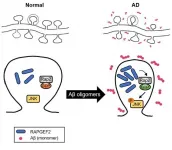(Press-News.org) A study aiming to develop a new therapeutic technique could bring a revolution in our approach to treating rare, fatal Sanfilippo syndrome, a disorder that affects children as young as 2 years old and leads to childhood dementia and premature death.
"We are using a combination of gene therapy, stem cells and small molecules to restore metabolic defects in the patient's brain cells" says Dr. Alexey Pshezhetsky, Professor at CHU Ste-Justine and lead GlycoNet Investigator on this project. "First results in the mouse models of the disease are very encouraging."
Sanfilippo syndrome belongs to a group of rare diseases known as lysosomal storage disorders.
The syndrome occurs in pediatric patients when the enzymes that the body needs to break down certain sugars are absent or defective. The sugars build up in the brain, causing severe damage.
"Children display symptoms like dementia," explains Pshezhetsky. "They experience behavioral problems and sleep disturbance, lose the ability to speak and most of them die before the age of 20."
Due to their individual rarity, lysosomal storage disorders have not traditionally been a focus for developing treatments. Only a few types have a treatment, and none of these has a cure.
Furthermore, the fact is that these "rare" diseases are not rare. Individually, they are considered rare, but collectively, they affect about 1 in 5,000 births. Moreover, some diseases are more frequent in specific populations such Tay-Sachs disease affecting Ashkenazi Jewish and French Canadians or Sandhoff disease with high prevalence in northern Saskatchewan.
A new treatment is needed
Lysosomal storage disorders that do not affect the brain are treated through enzyme replacement therapy, in which patients are injected weekly or monthly with the enzymes they lack. However, this treatment does not work well with Sanfilippo syndrome, as the injected enzymes cannot reach the brain--the place where they are needed.
"There is a physical barrier between the brain and the bloodstream that enzymes cannot pass through," says Pshezhetsky. "So, in cases where enzyme replacement therapy is ineffective, we are looking for new treatments that can potentially cure or ameliorate the disease."
In the method proposed by Pshezhetsky, he and his team are using a combination of gene therapy and transplantation of hematopoietic (blood-forming) stem cells. First, the patient's own stem cells are harvested and genetically corrected to eliminate enzyme defects. Then, these stem cells are injected back to the patient. Healthy blood cells that can secrete functional enzymes will proliferate and migrate to different tissues including the brain.
Unlike enzyme replacement therapy, this therapeutic technique will require only one-time treatment and would be in line with currently used clinical procedures. "It would be similar to a bone marrow replacement therapy. Once you get the treatment, you have a life-long supply of cells you need," says Pshezhetsky.
Based on the promising preliminary results of their mouse studies, Pshezhetsky and his colleagues are moving forward with plans to gather more data before testing the therapy in human patients.
Clinical applications to other types of rare disorders
Sanfilippo shares common pathology with other types of diseases in the same family of lysosomal storage disorders.
"About two-thirds of lysosomal storage disorders affect the brain. If we find out how to treat Sanfilippo syndrome, we can extend our knowledge to other similar diseases," says Pshezhetsky.
"I think it's important for people to know that recent discoveries lead to a paradigm shift for pediatric healthcare. Even if diseases are rare or ultra-rare we are not leaving patients behind but are developing customized ways to treat them," he adds.
There is a great potential for the novel treatment combining hemopoietic stem cells transplantation with gene therapies. This approach would be a new tool for clinicians to treat a range of rare genetic conditions that affect the brain.
INFORMATION:
The project is funded by GlycoNet, CIHR, Phenix Nest Inc., Sanfilippo Children's Research Foundation (Canada), and Jonah's Just Begun Foundation (USA).
ITHACA, N.Y. - During mating season, male bearded seals make loud calls to attract a mate. How loud? Well, even their "quiet" call can still be as ear-rattling as a chainsaw.
These elaborate vocalizations are essential for bearded seal reproduction, and have to be loud enough to be heard over the cacophony of their equally loud brethren.
But in the rapidly changing Arctic soundscape, where noise from industrial activities is predicted to dramatically increase in the next 15 years, bearded seals may need to adjust their calling behavior if they are ...
Washington, DC - February 24, 2021 - In the absence of effective treatments for COVID-19, many countries have approved the therapeutic use of blood plasma from recovering patients because it contains antibodies against the coronavirus. But not every type of antibody can neutralize the virus and render it noninfectious. New research published this week in mSphere, an open-access journal of the American Society for Microbiology, explores variation in virus neutralization capabilities, which can vary widely by type of antibody.
"What we need for plasma therapy is not only high levels of antibodies but also high neutralization capability," said virologist Michael Schindler, Ph.D, at University Hospital Tübingen, ...
X-rays are used to study the atomic and microstructure properties of matter. Such studies are conducted with special accelerator complexes called synchrotrons. A synchrotron source generates powerful electromagnetic radiation with a wavelength equal to fractions of a nanometer. Some X-rays are reflected from the atomic planes of a crystal and some go through the crystal plane that plays the role of a beam-splitter (or the so-called semitransparent mirror). If the radiation passes through monochromators-optical devices that consist of two or more ideal crystals - its optimal exit wavelength can be regulated. ...
Researchers have developed a data transfer system that can transmit information 10 times faster than a USB. The new link pairs high-frequency silicon chips with a polymer cable as thin a strand of hair. The system may one day boost energy efficiency in data centers and lighten the loads of electronics-rich spacecraft.
The research was presented at this month's IEEE International Solid-State Circuits Conference. The lead author is Jack Holloway '03, MNG '04, who completed his PhD in MIT's Department of Electrical Engineering and Computer Science (EECS) last fall and currently works for Raytheon. Co-authors include Ruonan Han, associate professor and Holloway's PhD adviser in EECS, and Georgios Dogiamis, ...
Korea Brain Research Institute (KBRI, Pann-Ghill Suh (President)) announced that Dr. Kea Joo Lee and Dr. You-Na Jang of the Neural Circuits Research Group have identified the mechanism causing synaptic loss in Alzheimer's disease as the aberrant expression of RAPGEF2, a synaptic protein.
- The results were published on January 2021, in the online Early View of Neuropathology and Applied Neurobiology.
* (Title) RAPGEF2 mediates oligomeric Aβ-induced synaptic loss and cognitive dysfunction in the 3xTg-AD mouse model of Alzheimer's disease
Alzheimer's disease (AD) accounts for about 75% of dementia cases and is the most common type of degenerative brain disease. AD is a devastating because disease progression can cause ...
Chemical & Engineering News (C&EN), the newsmagazine of the American Chemical Society (ACS), is celebrating Black chemists and chemical engineers with a special issue highlighting Black chemists who work across the fields of biotechnology, solar energy, pharmaceuticals and more. Guest edited by Massachusetts Institute of Technology (MIT) drug delivery pioneer Paula Hammond, Ph.D., this special issue showcases Black scientists, spotlighting their scientific passions and career accomplishments.
"In bringing into focus the unique lives of this set of accomplished Black scientists in chemistry and chemical engineering, ...
The steadily increasing prevalence and high costs of treating chronic joint pain worldwide poses a challenge for healthcare systems and healthcare payers. New research published today in END ...
The family of ENDOU enzymes is found in most organisms, yet its functions are only poorly understood. In humans, it has been connected with cancer. RNA viruses, such as SARS-CoV2, contain a gene corresponding to ENDOU, and this is important for virus replication and the suppression of the immune response. However, so far only few details of the role of these enzymes are known. The research group led by the molecular geneticist Dr. Wenjing Qi from the University of Freiburg now contributes some more details to its function in a study published by the renowned scientific journal Nature Communications. They suggest that the gene ENDU-2 could ...
Responding to artificial intelligence's exploding demands on computer networks, Princeton University researchers in recent years have radically increased the speed and slashed the energy use of specialized AI systems. Now, the researchers have moved their innovation closer to widespread use by creating co-designed hardware and software that will allow designers to blend these new types of systems into their applications.
"Software is a critical part of enabling new hardware," said Naveen Verma, a professor of electrical and computer engineering at Princeton and a leader of the research team. "The ...
More U.S. adults reported receiving or planning to receive an influenza vaccination during the 2020-2021 flu season than ever before, according to findings from a national survey.
The survey of 1,027 adults, conducted by the University of Georgia, found that 43.5% of respondents reported having already received a flu vaccination with an additional 13.5% stating they "definitely will get one" and 9.3% stating they "probably will get one." Combined, 66.3% have received or intend to receive an influenza vaccination.
By comparison, 48.4% of adults 18 and older received the vaccine during the 2019-2020 flu season, according to the Centers for Disease ...



